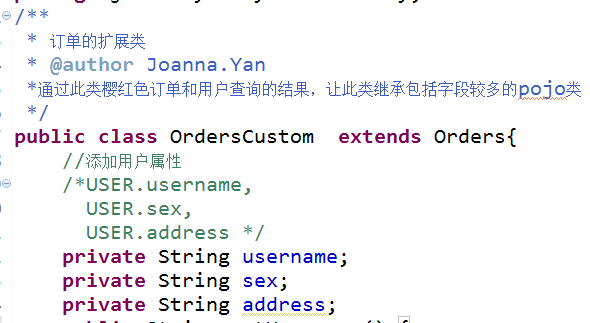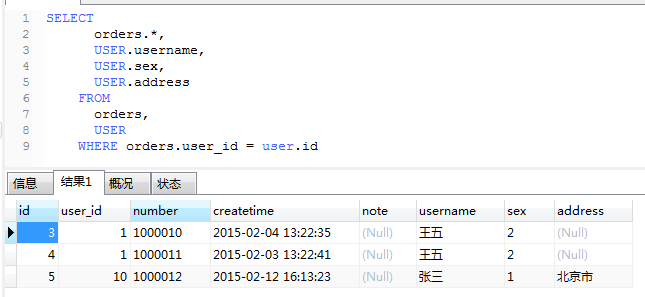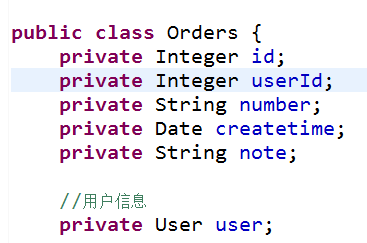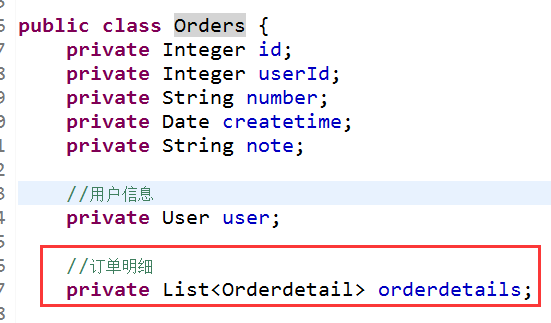Spring+SpringMVC+MyBatis深入學習及搭建(六)——MyBatis關聯查詢
1.商品訂單資料模型

1.1資料模型分析思路
(1)每張表記錄的資料內容
分模組對每張表記錄的內容進行熟悉,相當於你學習系統需求(功能)的過程。
(2)每張表重要的欄位設定
非空欄位、外來鍵欄位
(3)資料庫級別表與表之間的關係
外來鍵關係
(4)表與表之間的業務關係
在分析表與表之間的業務關係時,一定要建立在某個業務意義基礎上去分析。
1.2屬性模型分析

2.一對一查詢
2.1需求
查詢訂單資訊,關聯查詢下單使用者資訊。
2.2方法一:resultType
2.2.1sql語句
確定查詢的主表:訂單表
確定查詢的關聯表:使用者表
關聯查詢使用內連結?還是外連結?
由於orders表中有一個外來鍵(user_id),通過外來鍵關聯查詢使用者表只能查詢出一條記錄,可使用內連結。
SELECT orders.*, USER.username, USER.sex, USER.address FROM orders, USER WHERE orders.user_id = user.id
2.2.2建立pojo
將上邊sql查詢的結果對映到pojo中,pojo中必須包括所有查詢列名。
原始Orders.java不能對映全部欄位,需要新建立pojo。
建立一個pojo繼承包括查詢欄位較多的pojo類。

2.2.3mapper.xml
<?xml version="1.0" encoding="UTF-8"?> <!DOCTYPE mapper PUBLIC "-//mybatis.org//DTD Mapper 3.0//EN" "http://mybatis.org/dtd/mybatis-3-mapper.dtd"> <!--namespace名稱空間,作用就是對sql進行分類化的管理,理解為sql隔離 注意:使用mapper代理開發時,namespace有特殊作用,namespace等於mapper介面地址 --> <mapper namespace="joanna.yan.mybatis.mapper.OrdersCustomMapper"> <!--查詢訂單,關聯查詢使用者資訊 --> <select id="findOrdersUser" resultType="joanna.yan.mybatis.entity.OrdersCustom"> SELECT orders.*, USER.username, USER.sex, USER.address FROM orders, USER WHERE orders.user_id = user.id </select> </mapper>
2.2.4mapper.java
public interface OrdersCustomMapper { //查詢訂單,關聯查詢使用者資訊 public List<OrdersCustom> findOrdersUser() throws Exception; }
2.2.5測試程式
@Test public void findOrdersUserTest() throws Exception{ SqlSession sqlSession=sqlSessionFactory.openSession(); OrdersCustomMapper ordersCustomMapper=sqlSession.getMapper(OrdersCustomMapper.class); List<OrdersCustom> list=ordersCustomMapper.findOrdersUser(); System.out.println(list); sqlSession.close(); }
2.3方法二:resultMap
2.3.1sql語句
同resultType實現的sql

2.3.2使用resultMap對映的思路
使用resultMap將查詢結果中的訂單資訊對映到Orders物件中,在Orders類中新增User屬性,將關聯查詢出來的使用者資訊對映到orders物件中的user屬性中。
2.3.3需要orders類中新增user屬性

2.3.4mapper.xml
2.3.4.1定義resultMap
<!--訂單關聯查詢使用者的resultMap 將整個查詢的結果對映到oanna.yan.mybatis.entity.Orders中 --> <resultMap type="joanna.yan.mybatis.entity.Orders" id="OrdersUserResultMap"> <!-- 1.配置對映的訂單資訊 --> <!-- id:指定查詢列中的唯一標識,訂單資訊中的唯一標識,如果有多個列組成唯一標識,配置多個id column:訂單資訊中的唯一標識列 property:訂單資訊中的唯一標識列所對映到Orders類中的哪個屬性 --> <id column="id" property="id"/> <result column="user_id" property="userId"/> <result column="number" property="number"/> <result column="createtime" property="createtime"/> <result column="note" property="note"/> <!-- 2.配置對映的關聯的使用者資訊 --> <!-- association:用於對映關聯查詢單個物件的資訊 property:要將關聯查詢的使用者資訊對映到Orders類中的哪個屬性 --> <association property="user" javaType="joanna.yan.mybatis.entity.User"> <!-- 關聯查詢使用者的唯一標識 column:指定唯一標識使用者資訊的列 property:對映到user的哪個屬性 --> <id column="user_id" property="id"/> <result column="username" property="username"/> <result column="sex" property="sex"/> <result column="address" property="sex"/> </association> </resultMap>
2.3.4.2定義statement定義
<!--查詢訂單,關聯查詢使用者資訊,使用ResultMap --> <select id="findOrdersUserResultMap" resultMap="OrdersUserResultMap"> SELECT orders.*, USER.username, USER.sex, USER.address FROM orders, USER WHERE orders.user_id = user.id </select>
2.3.4.3mapper.java
public interface OrdersCustomMapper { //查詢訂單,關聯查詢使用者資訊,使用resultMap public List<Orders> findOrdersUserResultMap() throws Exception; }
2.3.4.4測試程式
@Test public void findOrdersUserResultMapTest() throws Exception{ SqlSession sqlSession=sqlSessionFactory.openSession(); OrdersCustomMapper ordersCustomMapper=sqlSession.getMapper(OrdersCustomMapper.class); List<Orders> list=ordersCustomMapper.findOrdersUserResultMap(); System.out.println(list); sqlSession.close(); }
2.4 resultType和resultMap實現一對一查詢小結
實現一對一查詢:
resultType:使用resultType實現較為簡單,如果pojo中沒有包括查詢出來的列名,需要增加列名對應的屬性,即可完成對映。
如果沒有查詢結果的特殊要求,建議使用resultType。
resultMap:需要單獨定義resultMap,實現有點麻煩,如果對查詢結果又特殊的要求,使用resultMap可以完成將關聯查詢對映pojo的屬性中。
resultMap可以實現延遲載入,resultType無法實現延遲載入。
3.一對多查詢
3.1需求
查詢訂單及訂單明細的資訊
3.2sql語句
確定主查詢表:訂單表
確定關聯查詢表:訂單明細表
在一對一查詢基礎上新增訂單明細表關聯即可。
SELECT orders.*, USER.username, USER.sex, USER.address, orderdetail.id orderdetail_id, orderdetail.items_id, orderdetail.items_num, orderdetail.orders_id FROM orders, USER, orderdetail WHERE orders.user_id = user.id AND orderdetail.orders_id=orders.id
3.3分析
使用resultType將上邊的查詢結果對映到pojo中,訂單資訊的就會重複。
要求:
對orders的對映不能出現重複記錄。
解決:
在Orders.java類中新增List<OrderDetail> orderDetails屬性。
最終會將訂單資訊對映到Orders中,訂單所對應的訂單明細對映到orders中的orderDetails屬性中。
對映成的orders記錄數為兩條(orders資訊不重複)
每個orders中的orderDetails屬性儲存了該訂單所對應的訂單明細。
3.4在Orders類中新增list訂單明細屬性

3.5定義resultMap
<!--訂單及訂單明細的resultMap 使用extends繼承,就不需要再配置訂單資訊和使用者資訊的映射了 --> <resultMap type="joanna.yan.mybatis.entity.Orders" id="OrdersAndOrderDetailResultMap" extends="OrdersUserResultMap"> <!-- 1.配置對映的訂單資訊 --> <!-- 2.配置對映的關聯的使用者資訊 --> <!-- 使用extends繼承,就不需要再配置訂單資訊和使用者資訊的映射了 --> <!-- 3.配置對映的訂單明細資訊 --> <!-- 訂單明細資訊 一個訂單關聯查詢出了多條明細,要使用collection進行對映 collection:對關聯查詢到的多條記錄對映到集合物件中 property:將關聯查詢到多條記錄對映到joanna.yan.mybatis.entity.Orders中的哪個屬性 ofType:指定對映到list集合屬性中pojo的型別 --> <collection property="orderdetails" ofType="joanna.yan.mybatis.entity.Orderdetail"> <!-- id:訂單明細的唯一標識 property:要講訂單明細的唯一標識對映到joanna.yan.mybatis.entity.Orderdetail的哪個屬性 --> <id column="orderdetail_id" property="id"/> <result column="items_id" property="itemsId"/> <result column="items_num" property="itemsNum"/> <result column="orders_id" property="ordersId"/> </collection> </resultMap>
3.6mapper.xml
<!-- 查詢訂單,關聯查詢使用者及訂單明細,使用resultMap --> <select id="findOrdersAndOrderDetailResultMap" resultMap="OrdersAndOrderDetailResultMap"> SELECT orders.*, USER.username, USER.sex, USER.address, orderdetail.id orderdetail_id, orderdetail.items_id, orderdetail.items_num, orderdetail.orders_id FROM orders, USER, orderdetail WHERE orders.user_id = user.id AND orderdetail.orders_id=orders.id </select>
3.7mapper.java
public interface OrdersCustomMapper { //查詢訂單,關聯查詢使用者資訊 public List<OrdersCustom> findOrdersUser() throws Exception; //查詢訂單,關聯查詢使用者資訊,使用resultMap public List<Orders> findOrdersUserResultMap() throws Exception; //查詢訂單(關聯使用者)及訂單明細 public List<Orders> findOrdersAndOrderDetailResultMap() throws Exception; }
3.8測試程式
@Test public void findOrdersAndOrderDetailResultMapTest() throws Exception{ SqlSession sqlSession=sqlSessionFactory.openSession(); OrdersCustomMapper ordersCustomMapper=sqlSession.getMapper(OrdersCustomMapper.class); List<Orders> list=ordersCustomMapper.findOrdersAndOrderDetailResultMap(); System.out.println(list); sqlSession.close(); }
3.9小結
mybatis使用resultMap的collection對關聯查詢的多條記錄對映到有個list集合屬性中。
使用resultType實現:
將訂單明細對映到orders中的orderdetails中,需要自己處理,使用雙重迴圈遍歷,去掉重複記錄,將訂單明細放在ordertails中。
4.多對多查詢
4.1需求
查詢使用者及使用者購買的商品資訊。
4.2sql語句
查詢主表:使用者表
關聯表:由於使用者和商品沒有直接關聯,通過訂單和訂單明細進行關聯,所有關聯表:orders、orderdetail、items。
SELECT orders.*, USER.username, USER.sex, USER.address, orderdetail.id orderdetail_id, orderdetail.items_id, orderdetail.items_num, orderdetail.orders_id, items.name items_name, items.detail items_detail, items.price items_price FROM orders, USER, orderdetail, items WHERE orders.user_id = user.id AND orderdetail.orders_id=orders.id AND orderdetail.items_id = items.id
4.3對映思路
將使用者資訊對映到user中。
在User類中新增訂單列表屬性List<Orders> orderslist,將使用者建立的訂單對映到orderslist;
在Orders中田間訂單明細列表屬性List<OrderDetail> orderdetails,將訂單的明細對映到orderdetails;
在OrderDetail中新增Items屬性,將訂單明細所對應的商品對映到Items。
4.4 mapper.xml
<select id="findUserAndItemsResultMap" resultMap="UserAndItemsResultMap"> SELECT orders.*, USER.username, USER.sex, USER.address, orderdetail.id orderdetail_id, orderdetail.items_id, orderdetail.items_num, orderdetail.orders_id, items.name items_name, items.detail items_detail, items.price items_price FROM orders, USER, orderdetail, items WHERE orders.user_id = user.id AND orderdetail.orders_id=orders.id AND orderdetail.items_id = items.id </select>
4.5定義resultMap
<!-- 查詢使用者及購買商品 --> <resultMap type="joanna.yan.mybatis.entity.User" id="UserAndItemsResultMap"> <!-- 1.使用者資訊 --> <id column="user_id" property="id"/> <result column="username" property="username"/> <result column="sex" property="sex"/> <result column="address" property="address"/> <!-- 2.訂單資訊 --> <!-- 一個使用者對應多個訂單,使用collection對映 --> <collection property="ordersList" ofType="joanna.yan.mybatis.entity.Orders"> <id column="id" property="id"/> <result column="user_id" property="userId"/> <result column="number" property="number"/> <result column="createtime" property="createtime"/> <result column="note" property="note"/> <!-- 3.訂單明細 --> <!-- 一個訂單包括多個明細 --> <collection property="orderdetails" ofType="joanna.yan.mybatis.entity.Orderdetail"> <id column="orderdetail_id" property="id"/> <result column="items_id" property="itemsId"/> <result column="items_num" property="itemsNum"/> <result column="orders_id" property="ordersId"/> <!-- 4.商品資訊 --> <!-- 一個訂單明細對應一個商品 --> <association property="items" javaType="joanna.yan.mybatis.entity.Items"> <id column="items_id" property="id"/> <result column="items_name" property="name"/> <result column="items_detail" property="detail"/> <result column="items_price" property="price"/> </association> </collection> </collection> </resultMap>
4.6mapper.java
public interface OrdersCustomMapper { //查詢訂單,關聯查詢使用者資訊 public List<OrdersCustom> findOrdersUser() throws Exception; //查詢訂單,關聯查詢使用者資訊,使用resultMap public List<Orders> findOrdersUserResultMap() throws Exception; //查詢訂單(關聯使用者)及訂單明細 public List<Orders> findOrdersAndOrderDetailResultMap() throws Exception; //查詢使用者購買商品資訊 public List<User> findUserAndItemsResultMap() throws Exception; }
4.7測試程式
@Test public void findUserAndItemsResultMapTest() throws Exception{ SqlSession sqlSession=sqlSessionFactory.openSession(); OrdersCustomMapper ordersCustomMapper=sqlSession.getMapper(OrdersCustomMapper.class); List<User> list=ordersCustomMapper.findUserAndItemsResultMap(); System.out.println(list); sqlSession.close(); }
4.8多對多查詢總結
將查詢使用者購買的商品資訊明細清單(使用者名稱、使用者地址、購買商品名稱、購買商品時間、購買商品數量)
針對上面的需求就使用resultType將查詢到的記錄對映到一個擴充套件的pojo中,很簡單實現明細清單的功能。
一對多是多對多的特例,如下需求:
查詢使用者購買的商品資訊,使用者和商品的關係是多對多關係。
需求1:
查詢欄位:使用者賬號、使用者名稱稱、使用者性別、商品名稱、商品價格(最常見)
企業開發中常見明細列表,使用者購買商品明細列表,
使用resultType將上邊查詢列對映到pojo輸出。
需求2:
查詢欄位:使用者賬號、使用者名稱稱、購買商品數量、商品明細(滑鼠移上顯示明細)
使用resultMap將使用者購買的商品明細列表對映到user物件中。
總結:
使用resultMap是針對那些對查詢結果對映有特殊要求的功能,比如特殊要求對映成list中包含多個list。
5.resultMap總結
resultType:
作用:將查詢結果按照sql列名pojo屬性一致性對映到pojo中。
場合:
常見一些明細記錄的展示,比如使用者購買商品明細,將關聯查詢資訊全部展示在頁面時,此時可直接使用resultType將每一條記錄對映到pojo中,在前端頁面遍歷list(list中是pojo)即可。
resultMap:
使用association和collection完成一對一和一對多高階對映(對結果又特殊的對映要求)。
association:
作用:將關聯查詢資訊對映到一個pojo物件中。
場合:
為了方便查詢關聯資訊可以使用association將關聯訂單資訊對映為使用者物件的pojo屬性中,比如:查詢訂單及關聯使用者資訊。
使用resultType無法將查詢結果對映到pojo物件的pojo屬性中,根據對結果集查詢遍歷的需要選擇使用resultType還是resultMap。
collection:
作用:將關聯查詢資訊對映到一個list集合中。
場合:為了方便擦還行遍歷關聯資訊可以使用collection將關聯資訊對映到list集合中,比如:查詢使用者許可權範圍模組及模組下的選單,可使用collection將模組對映到模組list中,將選單列表對映到模組物件的選單list屬性中,這樣做冊目的也是方便對查詢結果集進行遍歷查詢。
如果使用resultType無法將查詢結果對映到list集合中。
如果此文對您有幫助,微信打賞我一下吧~

相關推薦
Spring+SpringMVC+MyBatis深入學習及搭建(六)——MyBatis關聯查詢
1.商品訂單資料模型 1.1資料模型分析思路 (1)每張表記錄的資料內容 分模組對每張表記錄的內容進行熟悉,相當於你學習系統需求(功能)的過程。 (2)每張表重要的欄位設定 非空欄位、外來鍵欄位 (3)資料庫級別表與表之間的關係 外來鍵關係 (4)表與表之間的業務關係 在分析表與表之間的
Spring+SpringMVC+MyBatis深入學習及搭建(三)——MyBatis全局配置文件解析
保持 nbsp 延遲加載 行為 span 方便 doc ima actor 轉載請註明出處:http://www.cnblogs.com/Joanna-Yan/p/6874672.html 前面有寫到Spring+SpringMVC+MyBatis深入學習及搭建(二)&
Spring+SpringMVC+MyBatis深入學習及搭建(四)——MyBatis輸入映射與輸出映射
指定 2.6 face 生成 shm hashmap ace and 包裝 轉載請註明出處:http://www.cnblogs.com/Joanna-Yan/p/6878529.html 前面有講到Spring+SpringMVC+MyBatis深入學習及搭建(三)&
Spring+SpringMVC+MyBatis深入學習及搭建(八)——MyBatis查詢緩存
idt rtu void spring 寫到 查詢緩存 修改 針對 target 轉載請註明出處:http://www.cnblogs.com/Joanna-Yan/p/6956206.html 前面講到:Spring+SpringMVC+MyBatis深入學習及搭建(
Spring+SpringMVC+MyBatis深入學習及搭建(十)——MyBatis逆向工程
cat springmvc blank 不為 tex llc root from ssi 轉載請註明出處:http://www.cnblogs.com/Joanna-Yan/p/6973266.html 前面講到:Spring+SpringMVC+MyBatis深入學習及
Spring+SpringMVC+MyBatis深入學習及搭建(二)——MyBatis原始Dao開發和mapper代理開發
oid 方法註入 內部 需要 com 配置文件信息 lec lang auth 前面有寫到Spring+SpringMVC+MyBatis深入學習及搭建(一)——MyBatis的基礎知識。MybatisFirst中存在大量重復的代碼。這次簡化下代碼: 使用MyBatis開發
Spring+SpringMVC+MyBatis深入學習及搭建(四)——MyBatis輸入映射與輸出映射(轉發同上)
resultmap 根據 except 就會 ash 用戶名 mvc html like 原地址:http://www.cnblogs.com/shanheyongmu/p/7121556.html 1. 輸入映射 通過parameterType指定輸入參數的類型,類型可
Spring+SpringMVC+MyBatis深入學習及搭建(九)——MyBatis和Spring整合
1.整合思路需要Spring通過單例方式管理SqlSessionFactory。Spring和MyBatis整合生成代理物件,使用SqlSessionFactory建立SqlSession。(Spring和MyBatis整合自動完成)持久層的mapper都需要由Spring進
Spring+SpringMVC+MyBatis深入學習及搭建(八)——MyBatis查詢快取
1.什麼是查詢快取 mybatis提供查詢快取,用於減輕資料庫壓力,提高資料庫效能。 mybatis提供一級快取和二級快取。 一級快取是SqlSession級別的快取。在操作資料庫時需要構造sqlSession物件,在物件中有一個數據結構(HashMap)用於儲存快取資料。不同的sqlSession之間
Spring+SpringMVC+MyBatis深入學習及搭建(七)——MyBatis延遲載入
1.什麼是延遲載入 resultMap可以實現高階對映(使用association、collection實現一對一及一對多對映),association、collection具備延遲載入功能。 需求: 如果查詢訂單並且關聯查詢使用者資訊。如果先查詢訂單資訊即可滿足要求,當我們需要查詢使用者資訊時再查下使用
Spring+SpringMVC+MyBatis深入學習及搭建(四)——MyBatis輸入對映與輸出對映
1. 輸入對映 通過parameterType指定輸入引數的型別,型別可以是簡單型別、hashmap、pojo的包裝型別。 1.1 #{}與${} #{}實現的是向prepareStatement中的預處理語句設定引數值,sql語句中#{}表示一個佔位符即? <select id="findUse
Spring+SpringMVC+MyBatis深入學習及搭建(三)——MyBatis全域性配置檔案解析
MyBatis的全域性配置檔案SqlMapConfig.xml,配置內容和順序如下: properties(屬性) setting(全域性配置引數) typeAliases(類名別名) typeHandlers(類名處理器) objectFactory(物件工廠) plugins(外掛) environm
Spring+SpringMVC+MyBatis深入學習及搭建(十一)——SpringMVC架構
框架 ppi spring框架 edit 不同的 com get request html 轉載請註明出處:http://www.cnblogs.com/Joanna-Yan/p/6985816.html 前面講到:Spring+SpringMVC+MyBatis深入學習
Spring+SpringMVC+MyBatis深入學習及搭建(十四)——SpringMVC和MyBatis整合
文件拷貝 conf lips glib ide doc from ive body 轉載請註明出處:http://www.cnblogs.com/Joanna-Yan/p/7010363.html 前面講到:Spring+SpringMVC+MyBatis深入學習及搭建(
Spring+SpringMVC+MyBatis深入學習及搭建(五)——動態sql
mybatis核心:對sql語句進行靈活操作,通過表示式進行判斷,對sql進行靈活拼接、組裝。 mybatis提供各種標籤方法實現動態拼接sql。 1. if&where 1.2 需求 使用者資訊綜合查詢列表和使用者資訊查詢列表總數這兩個statement的定義使用動態sql。 對查詢條件進行判斷
【Spring+SpringMVC+MyBatis深入學習及搭建】17.SpringMVC攔截器
1.攔截器定義 Spring Web MVC的處理器攔截器類似於Servlet開發中的過濾器Filter,用於對處理器進行預處理和後處理。 定義攔截器,實現HandlerInterceptor介面。介面中提供三個方法。 package joanna.yan.ssm.interceptor; imp
spring深入學習(十六) IOC 之parentBeanFactory 與依賴處理
繼上篇部落格 【死磕 Spring】—– 載入 bean 之 快取中獲取單例 bean,如果從單例快取中沒有獲取到單例 bean,則說明兩種情況: 該 bean 的 scope 不是 singleton 該 bean 的 scope 是 singleton ,但是沒有初始化
Redis深入學習筆記(六)Redis內存分配
swa 如果 利用 技術分享 拷貝 back width byte hat Redis的高效可以說是輕量級的epoll模型和基於內存的讀寫共同組成的,所以內存的使用就至關重要,本篇主要介紹Redis的內存分配原理。 獲取內存信息命令:info memory used_me
多執行緒深入學習及面試解決思路
課程目標 執行緒與程序區別 為什麼要使用多執行緒? 多執行緒應用場景? 多執行緒建立方式 獲取執行緒物件以及名稱 守護執行緒 多執行緒執行狀態 join()方法作用 多執行緒分批處理資料 作業題 面試題 備註單詞 執行緒與程序區別
Dubbo服務治理框架深入學習及面試題
Dubbo概述 Dubbo的背景 隨著網際網路的發展,網站應用的規模不斷擴大,常規的垂直應用架構已無法應對,分散式服務架構以及流動計算架構勢在必行,亟需一個治理系統確保架構有條不紊的演進。 單一應用架構 當網站流量很小時,只需

